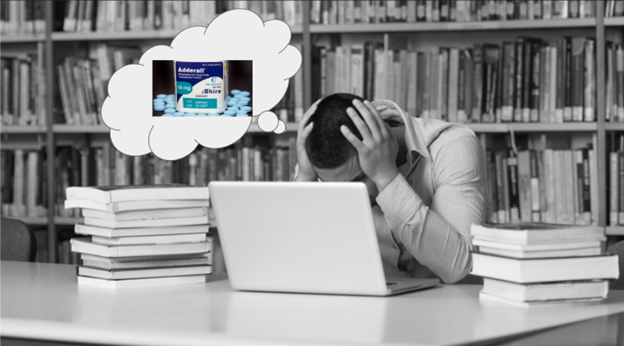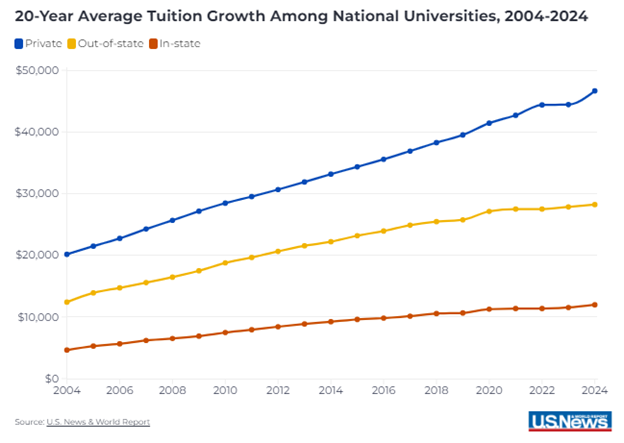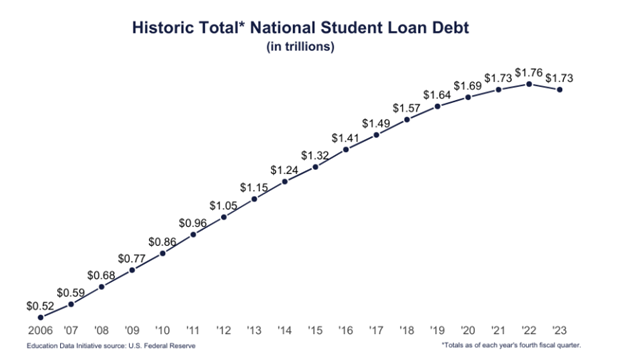College students face growing pressure to do well in school, and oftentimes this comes with higher levels of stress (Cooper 2017). To cope, some have turned to illicit usage of prescription stimulants meant for treatment of ADHD (Rolland and Smith 2017), in order to help with large amounts of difficult schoolwork.

This misuse of Adderall and other prescription stimulants is widespread, especially among college students. In some colleges, up to 40% of students report illicit usage of these drugs. Usage rates also tend to be higher at liberal arts colleges, and other selective universities with high admissions standards in the Northeastern United States (Cooper 2017).
Usage varies by student demographics. Male college students use prescription stimulants at a higher rate than their female counterparts, and students affiliated with a Greek organization are also more likely to use than others (Rolland and Smith 2017; Weyandt 2009).
The Neoliberalization of Higher Education
Neoliberalization refers to increasing “privatization, deregulation, competitive choice, market security, laissez-faire economics, and minimal government intervention” (Schraedly 2021). Rather than a competitive marketplace creating balance as intended, this trend has led towards students experiencing economic hardships due to the growing cost of education that stems from a lack of government funding (Schraedley 2021).
Many students feel as if universities and colleges have shifted from a space for learning to an environment for increasing one’s “future marketability” (Cooper 2017). This is largely due to the high and still growing price of college in the United States, as well as the sense of peer competition (Cooper, 2017).

Students are increasingly forced to take loans, which in some cases can lead to large amounts of debt. The uniquely high cost of college in this country that stems from a lack of government funding towards schools and students creates this looming financial pressure many young Americans face which then affects their approach to school (Hanson 2024).

Students suggest that using these drugs is simply ensuring a “return on investment”, in reference to the large sums of money students put towards their education (Cooper 2017).
This sense of college partially explains why prescription stimulant usage is legitimized in an academic setting. Some would say, if a student is investing so much into their future, they should make sure they get the most out of that investment.
High Academic Standards
Illicit prescription stimulant usage is closely linked to the high levels of stress students experience stemming from high quantities and difficulty of work. Many students who have reported illicit usage report it was during a finals week, or other periods of the school year when they experienced high levels of academic stress (Rolland and Smith 2017).
The heightened usage rates at selective Northeastern schools also affirm how high academic expectations tend to come with more stress, which in turn pressures students to turn to substances to help manage these pressures (Cooper 2017).
With high ambitions comes a large chance of falling short of one’s expectations, something that has been shown to hurt mental health and feelings of self-worth. This then causes the student to be more vulnerable to mental conditions such as anxiety or depression (Villareal 2015).
But Adderall is a ‘good’ Drug!
Students may point to that Adderall is not a drug intended to get someone “high”, but rather they are using it in a positive manner as a tool to do well in school (DeSantis and Hane 2010).

(DeSantis and Hane 2010)
The fact that prescription stimulants originate from pharmaceutical companies and are intended to treat illnesses enables students to legitimize the safe reputation of the drugs, compared to other stimulants that are viewed as “‘bad’ illegal street drugs” (DeSantis and Hane 2010; 36). Despite this perceived difference, Adderall is chemically near identical to methamphetamine, more commonly referred to as meth (Rolland & Smith 2017).
The FDA has published the following warning regarding Adderall:

Despite the FDA’s warnings against the misuse of Adderall, students persist in their habits due to their perceived harmlessness of the drug (DeSantis and Hane 2010).
Opposition to Adderall Use
Some college students believe that using these drugs specifically as a cognitive enhancement rather than a medication for a condition should be considered a form of cheating. Since college has become such a competitive environment, the use of Adderall in this manner gives students who use it an unfair advantage, some would say (Dodge 2012).
Prescription stimulants in an academic setting have been compared to anabolic steroids, drugs designed to heighten physical performance in athletics. The world of sports almost entirely views anabolic steroids in a negative way, Professional and Olympic sporting councils do not permit athletes to use them at all. However, in academics very few seem to bat an eye at the students using prescription stimulants as a cognitive enhancer (Dodge 2012).
Rethinking Academia; Prioritizing Diversity and Mental Health
The normalized use of prescription stimulants as a cognitive enhancer is possibly caused by wider societal beliefs and attitudes. Many mental illnesses are treated as something to fix, rather than a different way of living, or as a response to stressful environments.
College especially falls under this category. Not all students are naturally able to keep up with the demanding schedule selective colleges require. Students are showing signs of trying to emulate this ‘model’ student through substance use, one that can keep up with the exacting expectations experienced at one of these colleges.
Rather than pushing students towards one archetype, schools could move towards a system in which students that fall outside this model are appreciated, instead of feeling pressure to be different than their natural selves. The first step to this would have to be acting to lower tuition in order to free students from that financial pressure (Schraedley 2021). If this environment continues, drastic measures such as these to be productive will also continue to exist and grow, which would negatively affect the mental health of many students.
References:
Cooper, Amy. 2017. “‘At Such a Good School, Everybody Needs It’: Contested Meanings of Prescription Stimulant Use in College Academics.” AnthroSource. Retrieved March 25, 2024 (https://anthrosource.onlinelibrary.wiley.com/doi/full/10.1111/etho.12167).
Desantis, A. D., & Hane, A. C. (2010). “Adderall is Definitely Not a Drug”: Justifications for the Illegal Use of ADHD Stimulants. Substance Use & Misuse, 45(1–2), 31–46.
Dodge, T., Williams, K. J., Marzell, M., & Turrisi, R. (2012). Judging Cheaters: Is Substance Misuse Viewed Similarly in the Athletic and Academic Domains? Psychology of Addictive Behaviors, 26(3), 678–682. https://doi.org/10.1037/a0027872
Hanson, Melanie. “Student Loan Debt Statistics” EducationData.org, March 3, 2024, https://educationdata.org/student-loan-debt-statistics
Hanson CL, Burton SH, Giraud-Carrier C, West JH, Barnes MD, Hansen B. Tweaking and tweeting: exploring Twitter for nonmedical use of a psychostimulant drug (Adderall) among college students. J Med Internet Res. 2013;15(4):e62. Published 2013 Apr 17. doi:10.2196/jmir.2503
Rolland, Amber D. and Patricia J. Smith. 2017. “Aided by Adderall: Illicit Use of ADHD Medications by College Students.” Journal of the National Collegiate Honors Council 18(2). Retrieved 2024 (https://go.gale.com/ps/i.do?p=AONE&u=nysl_ce_hamilton&id=GALE%7CA523276377&v=2.1&it=r&aty=ip).
Schraedley, M.K., J.J. Jenkins, M. Irelan, and M. Umana. 2021. The neoliberalization of higher education: Paradoxing students’ basic needs at a Hispanic-serving institution. Frontiers in Sustainable Food Systems 5. https://www.frontiersin.org/articles/10.3389fsufs.2021.689499.
Villareal, B.J, Heckenhausen, J., Lessard, J., Greenberger, E., Chen, C., “High-school seniors’ college enrollment goals: costs and benefits of ambitious expectations” J. Adolescence, 45 (2015), pp. 327-340, 10.1016/j.adolescence.2015.08.012
Weyandt LL, White TL, Gudmundsdottir BG, et al. Neurocognitive, Autonomic, and Mood Effects of Adderall: A Pilot Study of Healthy College Students. Pharmacy (Basel). 2018;6(3):58. Published 2018 Jun 27. doi:10.3390/pharmacy6030058
Weyandt, L. L., Janusis, G., Wilson, K. G., Verdi, G., Paquin, G., Lopes, J., Varejao, M., & Dussault, C. (2009). Nonmedical Prescription Stimulant Use Among a Sample of College Students: Relationship With Psychological Variables. Journal of Attention Disorders, 13(3), 284-296. https://doi.org/10.1177/1087054709342212
Zetterqvist, J. 2012. “Stimulant and Non-Stimulant Attention Deficit⁄hyperactivity Disorder Drug Use: Total Population Study of Trends and Discontinuation Patterns 2006–